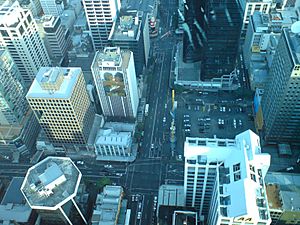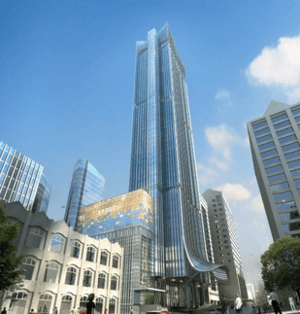NDG Auckland Centre facts for kids
The NDG Auckland Centre is a planned tall building for Auckland, New Zealand. It is meant to be a skyscraper with a Ritz-Carlton hotel inside. If it gets built, it would be the tallest building in New Zealand. It would stand about 209 metres (686 ft) high. This would make it the second-tallest structure in Auckland, after the famous Sky Tower.
This project was first announced as the 'Elliott Tower' by the Dae Ju Group. That was back in 2007. They even got permission to build it. But then, a big economic slowdown happened. This stopped the work in 2009. In 2012, a new developer from China, Furu Ding, bought the land. In 2014, Furu Ding said the project would go ahead as the NDG Auckland Centre. However, as of 2019, construction had not yet begun.
How the Project Started

The land for this building is on Albert Street. A hotel called the Royal International Hotel used to be there. In 1987, it was knocked down to build a new tall building. But that building was never built. Over the years, different owners had the land. Then, in 2003, a company from Korea called Dae Ju Group bought it.
In October 2007, the Elliott Tower project got permission to be built. It was planned for a block of land between Elliott, Victoria, and Albert Streets. This land was an empty space, used as a car park and for a reverse bungy ride. The tower was first planned to be 232 meters (761 feet) tall.
However, there was a problem in late 2007. SkyCity Auckland, which owns the nearby Sky Tower, was worried. They said the new building might cause problems for their communication equipment. They also worried about privacy for people in the new apartments. A law firm also joined the appeal. They said the tower went against city plans. By June 2008, these problems were solved. This meant the Elliott Tower could go ahead. Building was supposed to start in 2009 and finish by 2013.
The project then stopped because of a big financial crisis in 2008. In December 2013, Michael Barnett, a business leader in Auckland, thought construction would start soon. But there were new issues. The City Rail Link, a train tunnel, was being built under the site. This caused more delays for the NDG tower.
In 2017, the project got approval from the Overseas Investment Office. This office checks if foreign companies can invest in New Zealand. In the same year, NDG said building the Auckland Centre would depend on the City Rail Link. The train link is still being built and is expected to finish around 2024.
As of July 2019, there is no set date for when building will start or finish. The land is still being used as a car park.
What the Tower Would Be Like
The NDG Auckland Centre would mostly have apartments. These apartments would be for people who want very fancy homes. There would be two very large penthouses at the very top. These would be 445 and 590 square meters in size. Below them, there would be 57 floors of apartments. Fifty-two of these floors would be above ground, and five would be underground. They would all face both west and east. About 800 people could live there.
The building would also have three floors of shops. And there would be six levels of underground car parking. The design of the tower included many eco-friendly features. It would have solar panels to make electricity. It would also have special plants that absorb carbon to help the environment. A system to capture rainwater was also planned. There would be two "sky gardens" and a public garden on the shopping levels. These would be for people living in the building and for customers. These sky gardens would also make the building look nicer and help with wind flow. The new Aotea railway station, which is being built, would be right next to the site.
Building the Tower
When the project was first planned in 2007, it was thought it would be finished by 2011. About 500 full-time workers would be needed to build it. The first company to develop it was the Dae Ju Group. They are a construction company from Korea. They were also planning other buildings in the Auckland CBD area. They thought the tower would be worth about $450 million once it was finished.
In May 2017, after the Overseas Investment Office approved the project, the cost to build it was estimated to be $350 million.


